'30/9/2021
Britains 25 Million homes collectively emit more Carbon Dioxide and Nitrogen Oxides than all the Power stations in the UK. Tackling this problem could reduce the UK's Carbon Dioxide problem. As Gas herating is phased out in new builds there needs to be a greater move towards Air Source Heating systems and perhaps some Ground source heating systems. . These systems really do work even extracting heat at low temperatures of -8 Celcius. They work like a fidge and take in warm air and pump out cold air, the heat extracted is concentrated and used to heat water which is then pumped around the house ito warm the radiators. These heat pumps run on electricity and are very efficient because they don't use the electrticity to heat anything but instead get teh heat from the surrounding air but the problem is that they cost much more to install than gas boilers.
Photo Philip M Russell
29/9/2021
There seem to be ever more climate and environmental protests with Extinction Rebellion and Insulate Britain hitting the headlines with activities closing motorways and stopping work in Londaon. These protests certainly hit the headlines, but do these protests really work in raising awareness and getting peiple on the side of improving the climate situation. Studies on this a few and far between but seem to show the more Liberal people tend to get swept along with the protest and the more conservative people tend to ingnore what is going on. The really question is does it sway more people and persuade them to do more? Really only time will tell but at the moment these protests seem to annoy more poeple than persuade them.
Photo Sky News

28/9/2021
The North of England is home to 13 million people. However, this beautiful part of the country has just 7.6% of woodland cover, which is significantly lower than the England average. But a new Northern forest is being planned and starting to emerge. A scheme to plant 50 million trees has been given a £15 million grant by the government. Much of this planting will be allong the M62 Corridor giving 25,000 hectares of forest. The woodland trust can fund up to 100% of the costs of woodland creation and establishment in the Northern Forest area thanks to a grant from the Government’s Nature for Climate Fund.
Photo Philip M Russell

27/9/2021
Scientists at the University of Reading have warned that current projections of climate change do not take into account the fact that extratropical winds vary greatly from decade to decade. They found that that unusually hot, cold, wet or dry decades are projected to be much more likely by the middle of the century in the North Atlantic region than existing climate simulations suggest. "By adding this extra variability into climate models, we showed that these winds may be an additional source of uncertainty on top of climate change. This could mean that within these regions, temperatures are pushed to relatively extreme highs or lows more often. While in some decades they could counteract increases to temperatures and heavy rainfall caused by climate change, in other periods they could make these extremes even more extreme. This is yet another reminder that preparation will be crucial as we face up to more variable regional climates as an impact of climate change in the future."
Photo Pixabay

25/9/2021
Several large companies are calling on the UK Government to phase out all gas fired electricity power stations by 2035. This is just about achievable. It does mean a large investment in other forms of power - not just wind and solar which are dependent of the weather, but tidal and wave and geothermal energy too. Some businesses source all they power requirenments from renewable sources - but it is a bit more complex getting rid of all the fossil fuel power station but certainly not impossible if the government is willing to invest. This would certainly remove our dependence on buying in gas from other countries and being pressured to pay higher and higher Gas prices.
Photo Pixabay
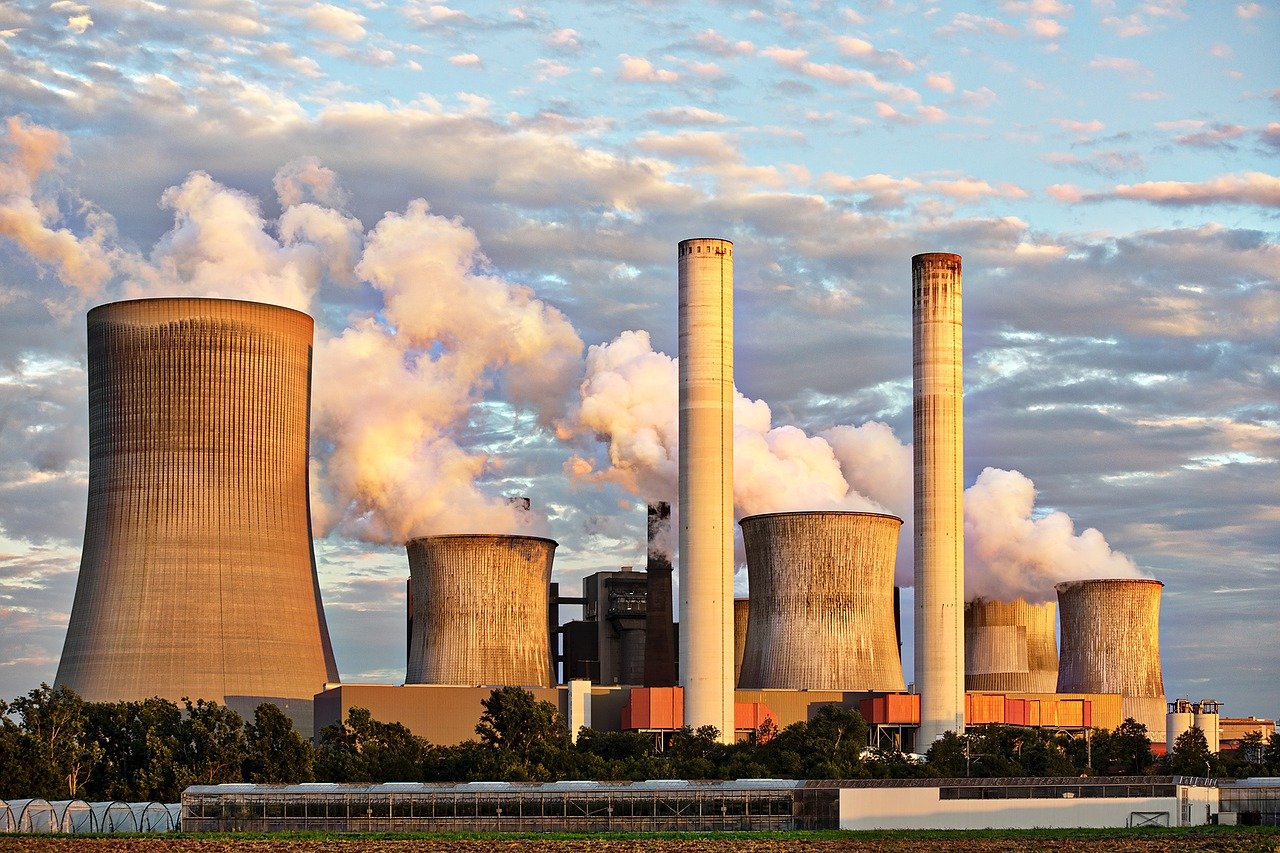
24/9/2021
The global climate change is having a radical effect on our oceans. Much of the food for life on Earth starts in the polar oceans. These cold loving eukaryotic algae photosynthesise and provide the food source for many many other creatures. As a food source they provide everything needed for all the other animals to grow and develop on. As the oceans warm these eukaryotic algea are being replaced by warm loving photosythentic prokaryotes which many of the other animals don't eat, or benefit as much from eating them. So as the oceans warm we could be set to see vast food webs in the oceans change, many animals being pushed to the point of extinction, and awaiting new spcies to eventually take over.
https://www.sciencedaily.com/releases/2021/09/210916114639.htm
Photo Pixabay

23/9/2021
China has began to enforce the 1987 Kigali Amendment to the Montreal Protocol last week. This protocol requires China and the second largest producer India to cease all production of a hydrofluorocarbon called HFC-23, a greenhouse gas that is 14,600 times more powerful than carbon dioxide. This chemical is a by product of making refrigerant. The amounts of this gas have been steadily increasing despite the Kigali Amendment because companies were paid a subsidy to easily destroy the gas. Some companies found the subsidy so good that they turned their production into making this gas so that they could be paid millions of dollars to destroy it. This subsidy stopped once Europe found out what was going on, so many companies now just dump the gas into the atmosphere. Only now has China started to act to get the companies to stop the pollution, but this could take decades to stop.
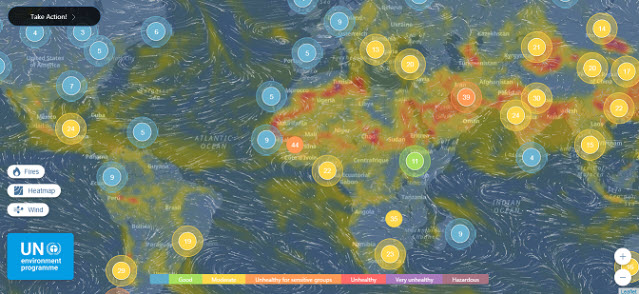
22/9/2021
With big gas price rises and lower than average wind and solar an energy crisis is looming - but is this true - lets look at some evidence. In the images below we can see the wind coloured cyan and the solar coloured yellow. The summer does seem down on last year for wind although the spring was similar to last year. Most of our wind comes in the Autumn gales and then will probably start soon. Solar has also been down this summer - we are looking at a bad year - but not much different than 2012. When the wind doesn't blow then the deficit in energy is made up by gas and at the moment with great demands on gas we are seeing this used and at a much higher price.
Photo from gridwatch.co.uk
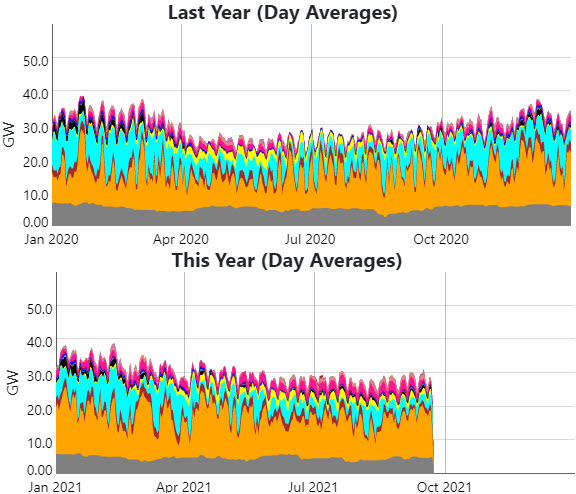
21/9/2021
Boris Johnson has warned the world’s rich countries that “history will judge”, if they fail to act now to tackle the climate crisis. Ten years ago countries pledged £73bn in climate financing, but most of this has not appeared. Boris said, “The world will see, and your people will remember, and history will judge ... Cop26 will be staged in the full glare of the global spotlight. And when the summit ends, when most of the world has committed to decisive, game-changing action, it will be clear to all which of us has lacked the courage to step up." Without singling out any individual countries, he added: “It is the biggest economies in the world that are causing the problem, while the smallest suffer the worst consequences. And while progress is being made all over the world, the gulf between what has been promised, what is actually being delivered, and what needs to happen … remains vast.” The UK is now entering the final leg of a series of frantic diplomatic effort to ensure that the Glasgow summit produces a significant agreement. The Cop26 president Alok Sharma has travelled to the US with Boris Johnson to press the case with individual countries. Alok Sharma told journalists in New York that of the G20 countries, only the G7 plus Argentina had so far produced the emission reduction targets they had committed to set ahead of Cop26. The US climate envoy John Kerry also suggested that President Biden was going to commit more funds to the fight.

20/9/2021
I guess that China a feeling upset. Instead of Australia having some submarines in a decade or so they will have access to USA and UK Submarmines in the next few weeks. China's plans in the South China seas my be monitored. China's trade war with Australia is not working well, so feeling backed into a corner they are being subbon about committing to attending COP26, and if they don't attend like many other countries trying some posturing to get better deals for their counties then will COP26 fail before it begins. Global warming is here. All the world needs to do something serious now because it is really already too late. Countries seem to be good at saying they will do something but we need more comittment and we need this from the whole world and we need this at COP26
Photo COP26
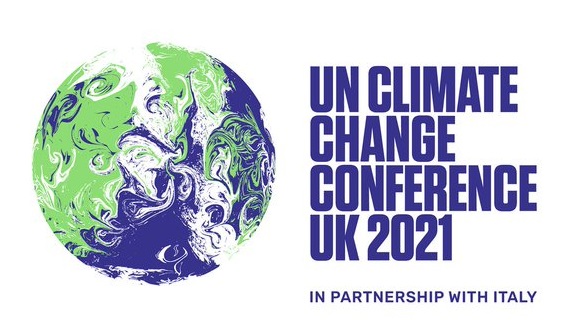
19/9/2021
Hikes in Gas prices are nothing new, but this one is also caused by less Gas coming from Russia. More expensive prices have allowed a couple of Fertilizer Factories ( the only one in the UK - USA owned) to stop the production of fertilizer which is leading to a lack of production of Carbon Dioxide. This Carbon Dioxide is used to stun the animals at the slaughter houses, so less Chicken and other meats. But this isn't the point. We are moving towards using less gas and so this process with reductions in the use of fossil fuels is supposed to continue like this. So it seems that the Governments need to start planning ahead and organising themselves.
Photo Philip M Russell
18/9/2021
The temporary reduction in carbon emissions caused by global COVID-19 lockdowns did not slow the relentless advance of climate change. Greenhouse gas concentrations are at record levels, and the planet is on path towards dangerous overheating, a multi-agency climate report published on Thursday warns. According to the landmark United in Science 2021, there “is no sign of growing back greener”, as carbon dioxide emissions are rapidly accelerating, after a temporary blip in 2020 due to COVID, and nowhere close to the targets set by the Paris Agreement. “We have reached a tipping point on the need for climate action. The disruption to our climate and our planet is already worse than we thought, and it is moving faster than predicted”, UN Secretary General António Guterres underscored in a video message. “This report shows just how far off course we are”, he added.
Photo Philip M Russell
17/9/2021
I did an experiment in the classroom yesterday making some hydrogen and it was colourless, but that isn't what the colours of hydrogen are all about. Most of all our hydrogen - a safe clean gas to burn for energy is called Brown Hydrogen, make from Fossils fuels and in the manufacture lots of Carbon and other toxic substances like sulfur are produced and typically let into the air. So although you may be using a clean fuel - hydrogen - its manufacture certainly was't.
Blue Hydrogen is made in exactly the same way but some of the Carbon and Sulfur are recovered and stored. The exact amount varies so some hydrogen made this way is very blue and some much less so.
The last type of hydrogen is Green Hydrogen - made from the electrolysis of water using electricity from renewable sources - Wonderful - but it still insn't because how much Greenhouse gases were using in the manufacture of the renea=wable energy machines and for the transport and storge of the hydrogen. Perhaps we should call this Cyan Hydrogen.
Photo Philip M Russell
16/9/2021
Ammonia is a big problem in Europe - Ammonia can break down into Nitrous Oxides which are high in Europe and are a greenhouse gas - and a potent one at that. So some researchers oin Germany have been condicting some experiments on cattle to see if they can be training to urinte in the same place and the urine collected and treated. Since cattle can produce up to 30 litres of urine a day this is a significant amount of greenhouse gases that can be potentially removed from the enviroment. Unfortunately the cattle can't be trained to defecate in the same way and that can't be stopped belching and farting out Methane, so although an intersting experiment it won't go far in removal of greenhouse gases from farms.
Photo Pixabay
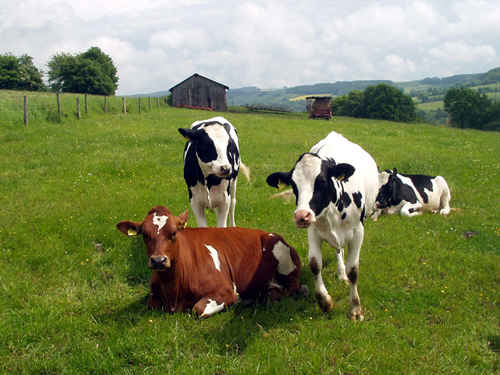
15/9/2021
10,000 young people aged 16-25 were recently surveyed in a study led by the University of Bath. Many of those questioned felt that that they have no future, and that governments were failing to respond to the closeness of climate change. Many felt that they were also powerless to do any thing about this. They felt betrayed, ignored and abandoned by politicians and adults. The authors say the young are confused by virtually all governments' failure to act to do anything. They say environmental fears are "profoundly affecting huge numbers of young people". The survey was carried out by the data analytics firm Kantar in the UK, Finland, France, the US, Australia, Portugal, Brazil, India, the Philippines and Nigeria. It's under peer review on open access.
Young people were asked their views on the following statements:
People have failed to care for the planet: 83% agreed globally, UK 80%
The future is frightening: 75%, UK 72%
Governments are failing young people: 65%, UK 65%
Governments can be trusted: 31%, UK 28%
Photo Pixabay
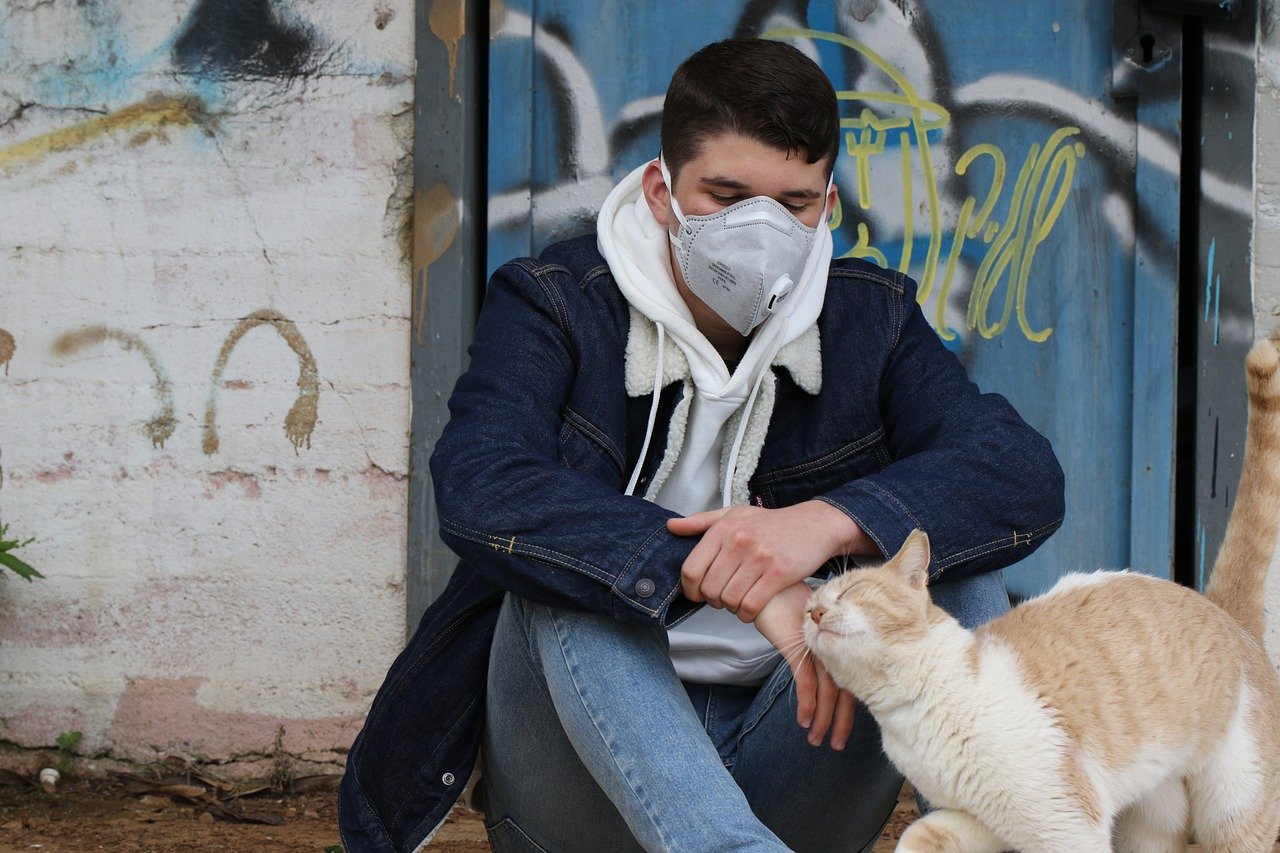
14/9/2021
Without an early and concerted climate and development action, as many as 216 million people could need to move within their own countries due to slow-onset climate change impacts by 2050. They will migrate from areas with lower water availability and crop productivity and from areas affected by sea-level rise and storm surges. Hotspots of internal climate migration could emerge as early as 2030 and continue to spread and intensify by 2050. The reports also finds that rapid and concerted action to reduce global emissions, and support green, inclusive, and resilient development, could significantly reduce the scale of internal climate migration. This new report builds on the scenario-based modeling approach of the previous Groundswell report from 2018, which covered Sub-Saharan Africa, South Asia, and Latin America and this report moved onto include East Asia and the Pacific, North Africa, and Eastern Europe and Central Asia.
https://openknowledge.worldbank.org/handle/10986/36248
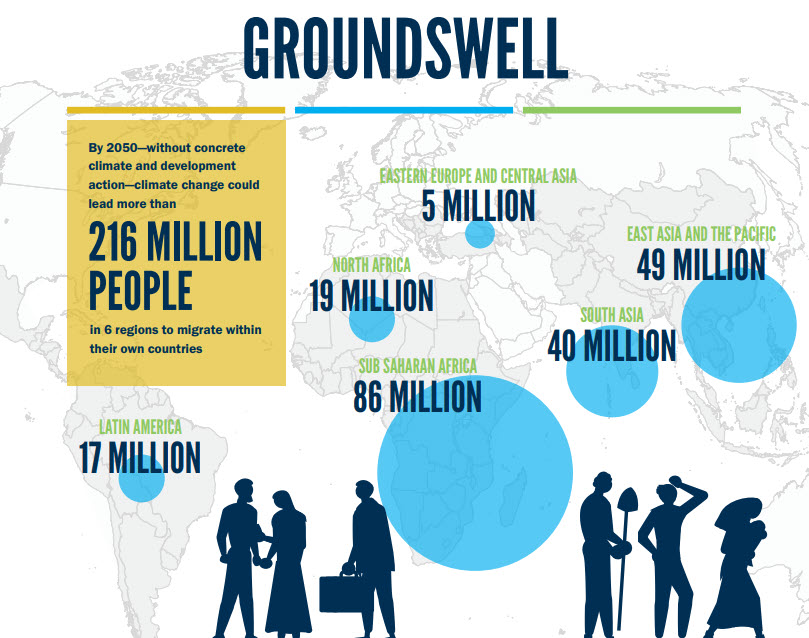
13/9/2021
The Climate Action Network (CAN), a global alliance of more than 1,500 climate and environmental campaign groups, urged organisers to postpone the Cop26 saying that going ahead with an in-person event would exclude many government delegates, campaigners and journalists, particularly those from developing countries who are on the UK’s “Covid-19 red list“. Anyl Cop26 delegates arriving from a red list country will be required to quarantine for five days if they are vaccinated and ten days if they aren’t. CAN says this would pose “serious and long-lasting implications” for some of the key issues and developing country priorities under negotiations at the talks, including on climate finance, loss and damage and the design of new carbon market rules. “If Cop26 goes ahead as currently planned, I fear it is only the rich countries and NGOs from those countries that would be able to attend. This flies in the face of the principles of the UN process and opens the door for a rich nations stitch-up of the talks,” warned Mohamed Adow, director of the Nairobi-based think tank Power Shift Africa.

12/9/2021
A few years ago targets were set to reduce the Carbon Dioxide emissions and everyone thought that the Global warming would come in gradually and in a liear fashion. Global warming doesn't seem to be linear, smooth or gradual as this summer has shown. Everywhere, the programmes that are designed to avert the crisis are very linear, smooth and gradual. Complex systems such as the atmosphere, oceans and biospherewant an equilibrium. When they are pushed too far out of one equilibrium state, they can flip suddenly into another state. It is much easier to push them past a tipping point than to push is back from one and once a transition has occured. The tipping point cannot be reversed without pushing it far in the other direction. Looking at many systems such as the West and East Antarctic ice sheets, the Amazon rainforest, and the Arctic tundra and boreal forests, these are rapidly losing the carbon they store, driving a spiral of further heating. Earth systems are all related to one another. If one flips into a different state, it could trigger the flipping of others. Sudden changes of state might be possible with just 1.5C or 2C of global heating and some of that could be hgappening right now. COP26 needs to move the targets much closer 2050 is out - and 2030 is looking dangerous for net zero .
Photo Pixabay
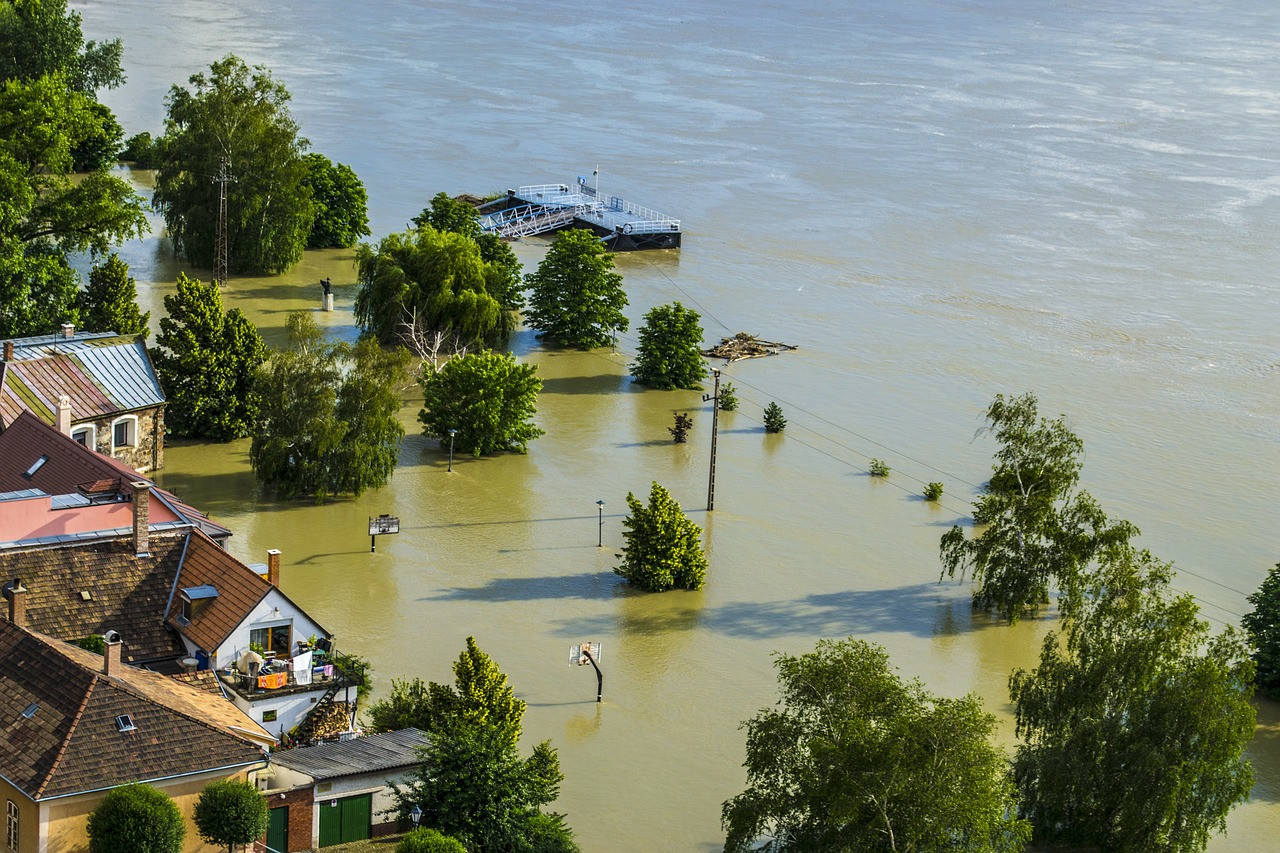
11/9/2021
Dutch politicians are considering plans to force hundreds of farmers to sell up and cut livestock numbers, to reduce damaging ammonia pollution. The Dutch administrative court found in 2019 that the government was breaking EU law by not doing enough to reduce excess nitrogen in vulnerable natural areas. The country is battling what it is called a “nitrogen crisis”. Daytime speed limits have been reduced to 100kmph (62mph) on motorways to limit nitrogen oxide emissions, gas-guzzling construction projects have been halted and a new law pledges that by 2030 half of protected nature areas will have healthy nitrogen levels. Livestock produce manure which, when mixed with urine, releases ammonia, a nitrogen compound. If this gets into lakes and streams via farm runoff, the excessive nitrogen can damage sensitive natural habitats by, encouraging algae blooms that deplete oxygen in surface waters. The Netherlands has one of Europe’s largest livestock industries, with more than 100m million cattle, chickens and pigs. It is also the EU’s biggest meat exporter.
Photo USDAgov under CC Licence

10/9/2021
"Orca" is the name of Climeworks' new direct air capture and storage plant in Iceland. It will take carbon dioxide removal to the next level by combining Climeworks' direct air capture technology with the underground storage of carbon dioxide provided by Carbfix. Orca will capture 4000 tons of CO₂ per year - making it the world's biggest climate-positive facility to date. Using Climeworks state of the art technology is one of the most impactful ways to stop climate change. This form of carbon capture called direct air capture (DAC), a method of geoengineering that’s become controversial in recent years for its dubious efficacy and practicality. DAC proposes to slow climate change by sucking greenhouse gasses like CO2 directly from the atmosphere, DAC has splintered environmentalists, some of whom laud it as a potential savior, while others call it as a costly, risky distraction from meaningful emissions distractions
Photo https://climeworks.com/orca
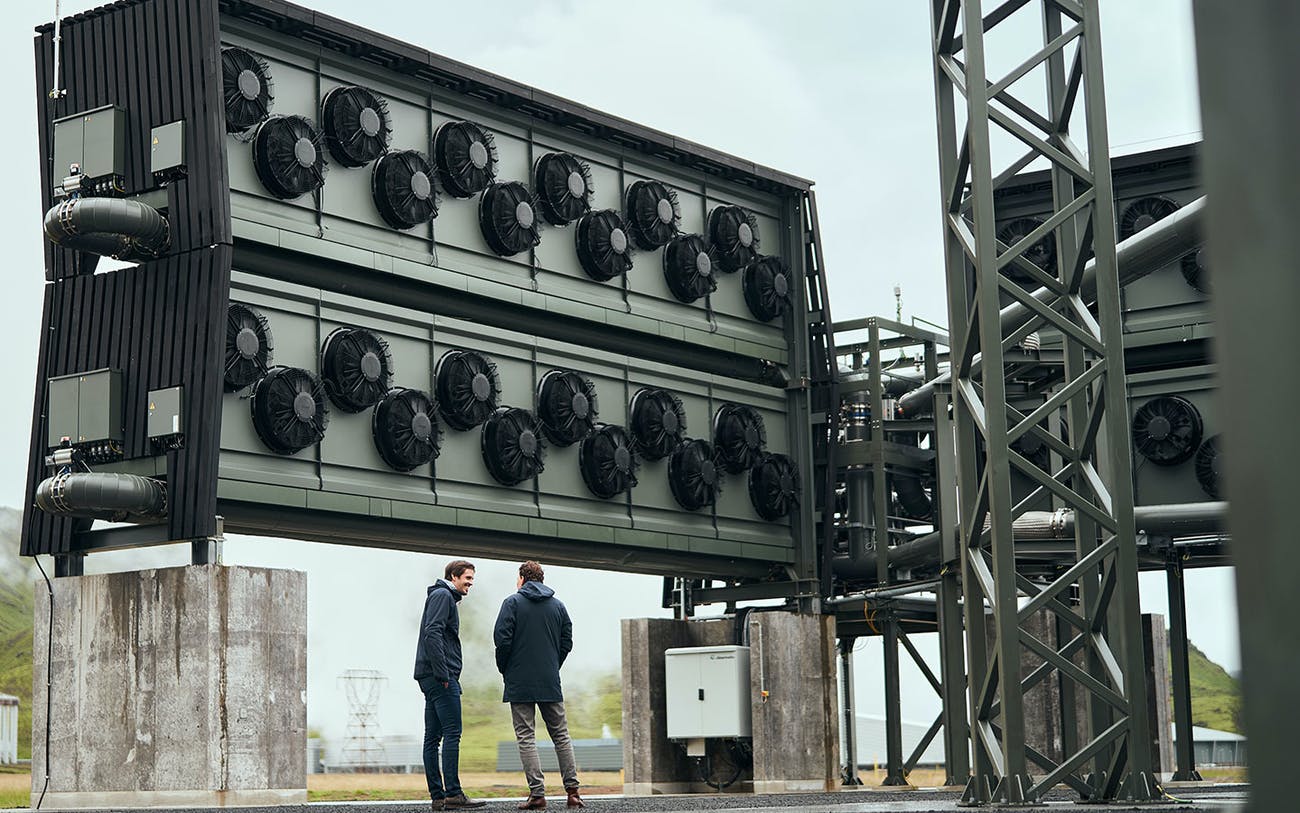
9/9/2021
It is very likely that we will breach the 1.5°C barrier in the next 29 years. It is even more likely to be much earlier than that because since the Paris Accord many countiries coal oil and gas consumption has increased rather than gradually decreasing. We need to globally reduce emissions by 7.6% and if some countries are increasing others must reduce more. In the news yesterday was the Trade agreement with Australia omitting some green taergets because Australia is still using loads of coal. production of fossil fuels needed to have peaked in 2020 and be on a steady decline of 3% every year until 2050. Through the Covid pandemic, there has been a large decline in production - but this is bouncing back. One-third of oil reserves, almost half of fossil methane gas reserves and over 80% of current coal reserves will need to remain in the ground by 2050 to limit warming to 2 °C. Some countries would need to leave much higher proportions of fossil fuel reserves in the ground than others.
Photo Pixabay
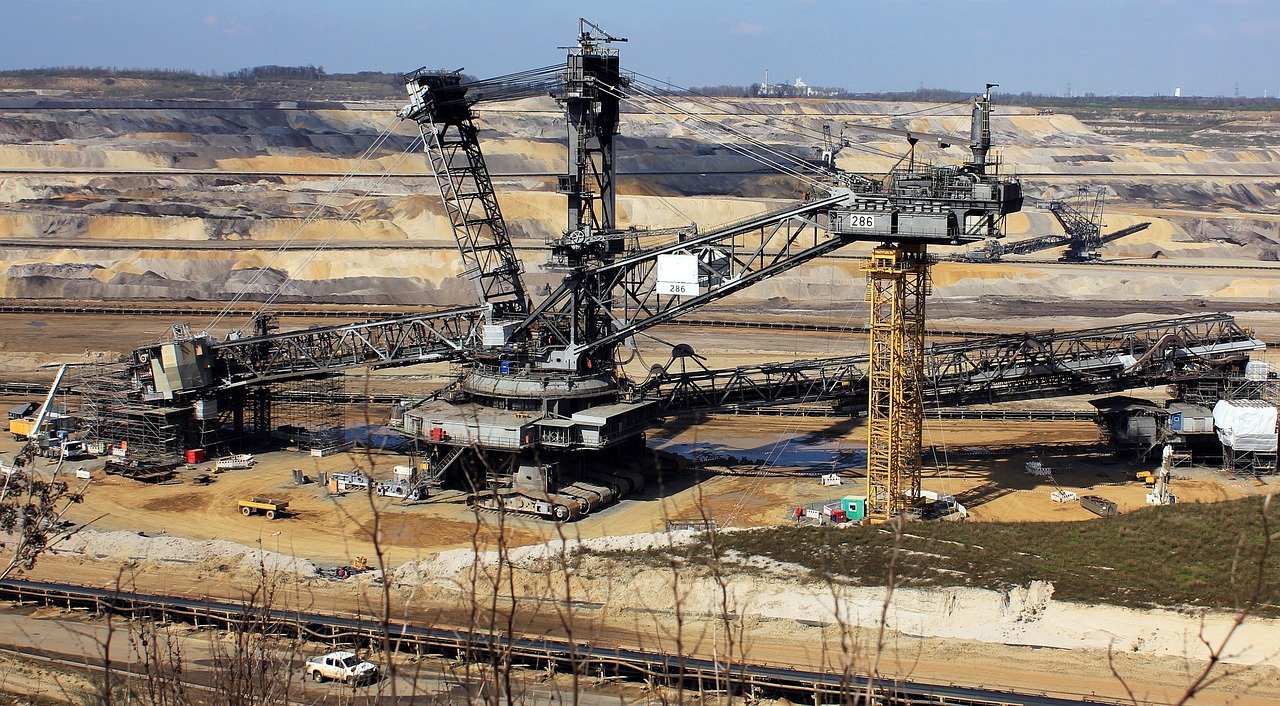
8/9/2021
Many animal appendages, such as avian beaks and mammalian ears, can be used to dissipate excess body heat. Allen’s rule, wherein animals in warmer climates have larger appendages to facilitate more efficient heat exchange, reflects this. A new study in the Journal Tends in Ecology and Evolution finds that there is widespread evidence of ‘shape-shifting’ (changes in appendage size) in endotherms in response to climate change and its associated climatic warming. They have re-examined studies of morphological change over time within a thermoregulatory context, finding evidence that temperature can be a strong predictor of morphological change independently of, or combined with, other environmental changes. They have also looed at Allen’s rule, the degree of temperature change, and other ecological factors facilitate morphological change and make predictions about what animals will show shape-shifting.
https://www.cell.com/trends/ecology-evolution/fulltext/S0169-5347(21)00197-X
Photo Pixabay
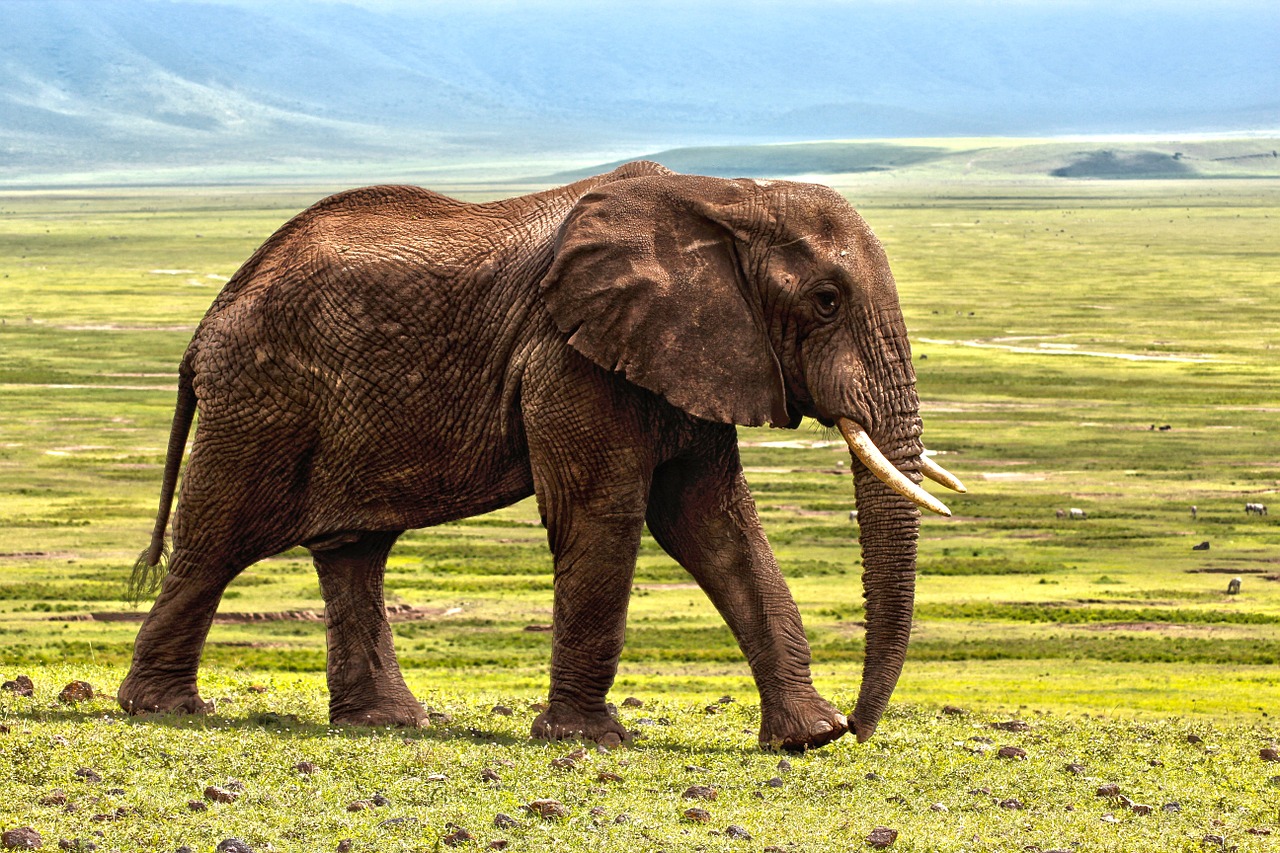
7/9/2021
The Science demands that we need to reduce global emissions
by 7.6% per year – or 50% within the 2020s – while also reversing
biodiversity loss if we want to reach net zero by 2040. This is just straight
forward maths. The first part of the cut down is easy but as we get nearer and
nearer net zero the target becomes more difficult.
But while we can see many countries offer wonderful
commitments for net zero in or before the 2040s, examples of these already
cutting annual emissions by 7.6% are very few and far between.
So, we need far more action and less talk. COP26 is the
opportunity for all the countries to show how they have exceeded the necessary
7.6%. If this is not the case as expected then their targets will need to be
significantly higher.
Photo Pixabay

6/9/2021
Beijing
has rebuffed American calls to make more public pledges on climate change before
a UN climate summit in November, insisting it should follow its own plan rather
than bowing to US pressure, according to a person familiar with the two
countries’ negotiations. During talks with Chinese
leaders in Tianjin, US climate envoy John Kerry presented a list of
proposals for Beijing to accelerate its climate efforts. They included a public
commitment to the 1.5 degrees Celsius (2.7 degrees Fahrenheit) limit of global warming targeted
in the 2015 Paris Agreement,
a definite time frame for carbon emissions to peak before 2030, and a
moratorium on financing overseas coal-fired projects. But
the two sides failed to reach agreement, according to the source, who requested
anonymity. “China already has its own plans and road map for achieving its
climate goals,” said the person, adding China would not accept Washington telling
it what to do and when.
Photo South China Morning Post

5/9/2021
Four commercially-fished tuna species are on the path to recovery thanks to the enforcement of regional fishing quotas over the last decade, according to today’s update of the IUCN Red List of Threatened Species™ released at the IUCN World Conservation Congress in Marseille. However, the recovery comes in the midst of growing pressures on marine species, with 37% of the world’s sharks and rays now threatened with extinction primarily due to overfishing, compounded by loss and degradation of habitat and climate change. In the latest Red List update, the seven most commercially fished tuna species were reassessed. Four of them showed signs of recovery thanks to countries enforcing more sustainable fishing quotas and successfully combatting illegal fishing. The Atlantic bluefin tuna (Thunnus thynnus) moved from Endangered to Least Concern while the Southern bluefin tuna (Thunnus maccoyii) moved from Critically Endangered to Endangered. The albacore (Thunnus alalunga) and yellowfin tunas (Thunnus albacares) both moved from Near Threatened to Least Concern.
https://www.iucn.org/news/species/202109/tuna-species-recovering-despite-growing-pressures-marine-life-iucn-red-list
Photo
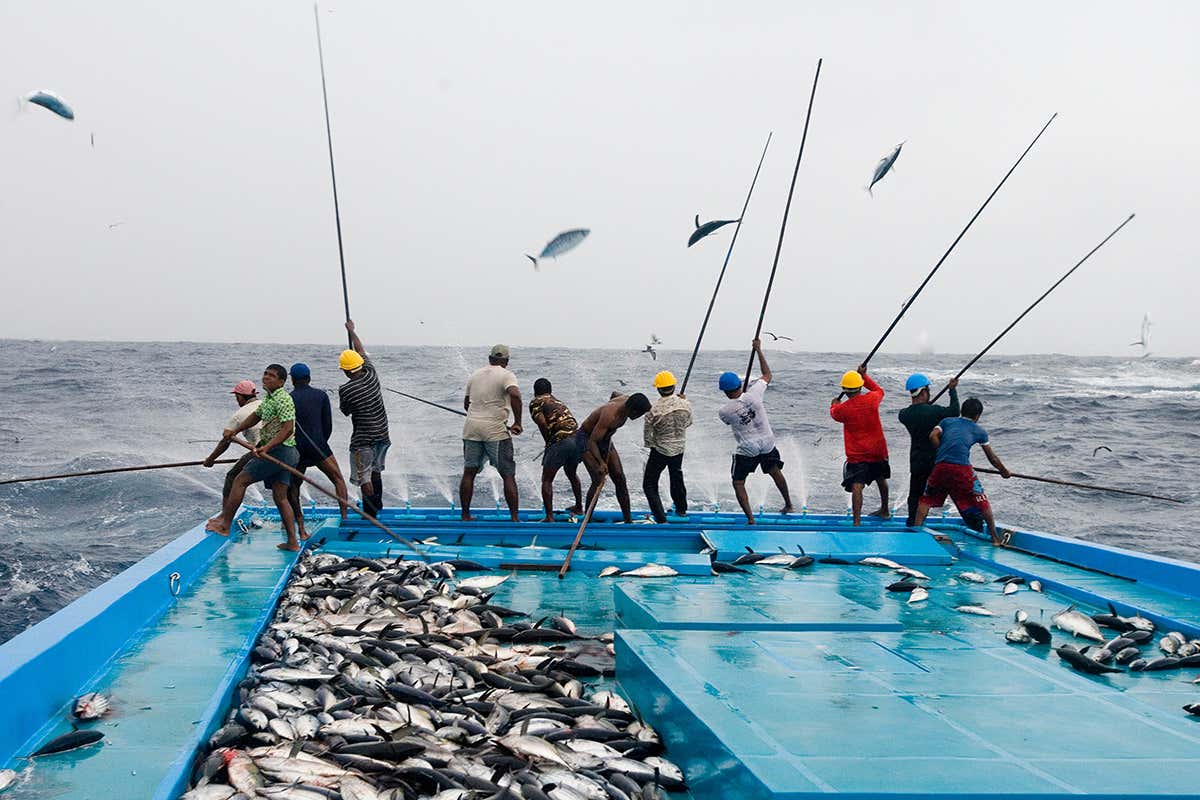
4/9/2021
The Arctic is warming at a rate twice the global average and severe winter weather is reported to be increasing across many heavily populated mid-latitude regions, but there is no agreement on whether a physical link exists between the two phenomena. A study used observational analysis to show that a lesser-known stratospheric polar vortex (SPV) disruption that involves wave reflection and stretching of the SPV is linked with extreme cold across parts of Asia and North America, including the recent February 2021 Texas cold wave, and has been increasing over the satellite era. The scientiststs then used numerical modeling experiments forced with trends in autumn snow cover and Arctic sea ice to establish a physical link between Arctic change and SPV stretching and related surface impacts.
https://www.science.org/doi/10.1126/science.abi9167
Photo USFWS heaquarters by CC Licence

3/9/2021
Yesterday we reported about no more leaded fuel
sold worldwide, however in the USA 167,000 piston-engine aircraft still fly
using lead aviation fuel.
In the US, Janet McCabe, deputy administrator at
the Environmental Protection Agency, said the EPA was working with the Federal
Aviation Administration to address the continued use of leaded fuel in some
aircraft operating in the country.
This is believed to be the only remaining transport
fuel containing lead. This is to prevent serious engine “knock”, which can
result in a sudden engine failure. Through various initiatives, the industry
was supposed to identify an unleaded fuel by 2018 but the testing completion
date was pushed back to 2021.
Photo PIxabay

2/9/2021
Algeria, the last country in the world to use leaded petrol has stopped selling the highly toxic fuel, bringing an end of its use in cars, the United Nations (UN) environment office said on Monday. The toxic fuel has contaminated the world's air, soil and water for virtually a century.
The lead in Petrol can cause a range of diseases, including heart disease, cancer and strokes, and has been linked to problems with brain development in children. Most high-income countries banned the fuel by the 1980s, but it was only this July that Algeria - the last country in the world still to use leaded petrol - ran out.
Lead started to be added to petrol in the early 1920s to stop the "knocking" in engines. The hazards of lead in petrol were raised in 1924, when five workers died and dozens more hospitalised after suffering convulsions at a refinery in the US by the company Standard Oil. However lead continued to be added to all petrol globally until the 1970s. A 19-year campaign by the UN has pushed for other countries to follow suit, and Algeria was the last to stop providing the petrol this July. Now, the sale and use of this fuel has ended globally. Unfortunately it will take the world years to recover.
Photo PIxabay

1/9/2021
A team of researchers, led by Dr Sev Kender from the University of Exeter, have made a breakthrough in the cause of the last major Global Warming event which lasted 150 thousand years. It looks like it was caused by a huge amount of volcanic activity. Crucially, the research of the rock samples in the North Sea showed that in the early stages of the Global Warming, there was a significant drop in mercury levels -- suggested at least one carbon reservoir released a significant amount of greenhouse gases as the phenomenon took hold. The research indicates the existence of tipping points in the Earth's System -- which could trigger the release of additional carbon reservoirs that drove the Earth's climate to unprecedented high temperatures. Now this time it is man who is releasing the carbon resevoirs.
"We wanted to test the hypothesis that this unprecedented greenhouse gas release was triggered by large volcanic eruptions. As volcanoes also release large quantities of mercury, we measured the mercury and carbon in the sediment cores to detect any ancient volcanism. "The surprise was that we didn’t find a simple relationship of increased volcanism during the greenhouse gas release. We found volcanism occurred only at the beginning phase, and so another source of greenhouse gasses must have been released after the volcanism.” https://www.exeter.ac.uk/news/homepage/title_874577_en.html
Photo PIxabay

New ways, New technology